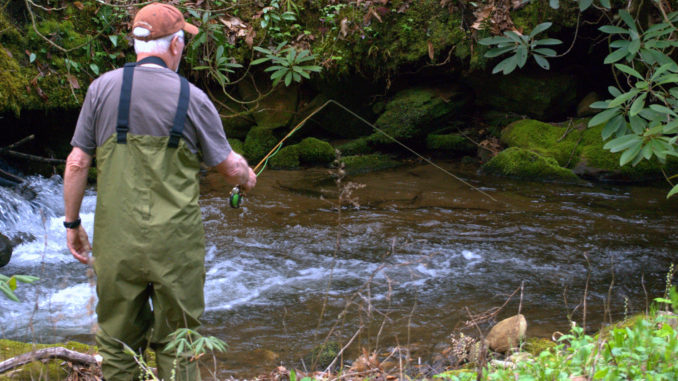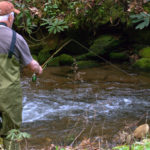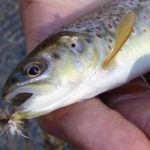
Tiny wild-trout streams abound in mountains
More than 3,000 miles of trout waters flow through the North Carolina mountains, an intricate web of rivers, creeks, forks, branches and springlets — some hundreds of feet wide, some only a few feet wide. The amazing part is that many of these streams, large and small, contain decent populations of trout.
At least a third of these streams are hatchery-supported, stocked on a regular basis with catchable-size trout at least seven inches long. The remainder have self-sustaining populations of wild trout. The majority are rainbows, with a smaller number of brown trout and an even smaller number of native brook trout. Depending on the type of water, most of the trout in wild-trout streams are small, usually six or seven inches. Wild-trout streams, large and small, do produce big trout if enough food is available. I’ve caught 12-inch wild trout in streams I could jump across. Trout that large in small steams are a rarity, of course, but it happens often enough to keep me fishing them. Even if the trout are small, they fight like fish twice their size.
Fishing smaller streams does require work. You have to crawl through rhododendron thickets, scale rock cliffs, spend a lot of time hunched over and fishing on your knees. Flies will get caught in laurel branches, but since the stream is small, you can retrieve a fly without too much effort and move on to the next likely spot. Long casts are rare. Most times I’ll have no more than 15 feet of line out, and I use a pitching technique used by bass fishers to slide a fly under laurel branches on the sides of streams. Secure the line with your casting hand and pitch or roll cast the fly ahead as you wade upstream.
Plunge pools and stream banks are the places where most trout hold. The main sections of small streams usually are too shallow or the water is too swift for trout.
Trout in small streams are extremely wary, and if you miss a strike, move on; they won’t hit a second time. Keep a low profile and keep noise to a minimum. Wild trout are sensitive to sound and motion. They may not see you, but they certainly can hear you coming.
Small flies are preferred, usually no larger than a No. 18. I have the most success with a parachute Adams in the spring and an inchworm or black ant pattern in the summer. A small Hare’s Ear tumbled through a plunge pool or dabbled in the foamy water of a plunge pool also works well.
One big advantage of fishing small streams is the low traffic; I usually have a stream all to myself.
One of my favorite small streams is Moses Creek, a mile or so from my front door in Jackson County; I fish the wild-trout section in the Nantahala National Forest. Moses Creek is a tributary of Caney Fork, which is a tributary of the Tuckasegee River. Why would I name one of my favorite streams? Because not that many people would go to the trouble to fish it; it requires too darn much work.
Small streams are easy to locate. Get a copy of North Carolina Trout Fishing Maps. Locate the larger trout streams and then find the tributaries that feed them.
Here’s a small listing of some of the more productive small streams, all wild-trout waters:
• Slickrock Creek in Graham County. Located in the Slickrock Wilderness area close to the Tennessee state line, no roads lead to this stream, only hiking trails. The stream is known for its brown trout.
• Looking Glass Creek, a tributary of the Davidson River in Transylvania County. Most of the creek runs along U.S. 276 and includes the popular Sliding Rock Recreation Area. Rainbow trout are the prevalent species.
• Camp Creek in Avery County, a tributary of the Linville River. The creek has mostly wild brown trout. Access is from the Blue Ridge Parkway between mileposts 315 and 317 near the town of Linville Falls.
• Big Creek, a tributary of Cane River in Yancey County. The stream has mostly small rainbow trout. Access is from US 19W north of Ramseytown.
• Caldwell Fork in Cataloochee Valley in Haywood County. The stream has a good population of small rainbow trout. Access is from Caldwell Fork Trail off New Cataloochee Road.
• Collins Creek, a tributary of the Oconaluftee River. It has a good population of rainbow and brook trout. Access is from Newfound Gap Road at the Collins Creek Picnic Area in the Great Smoky Mountains National Park.
You won’t catch a trophy-size trout fishing the small streams, but you will catch trout, and you’ll be fishing in some of the more scenic sections of the mountains.







Be the first to comment